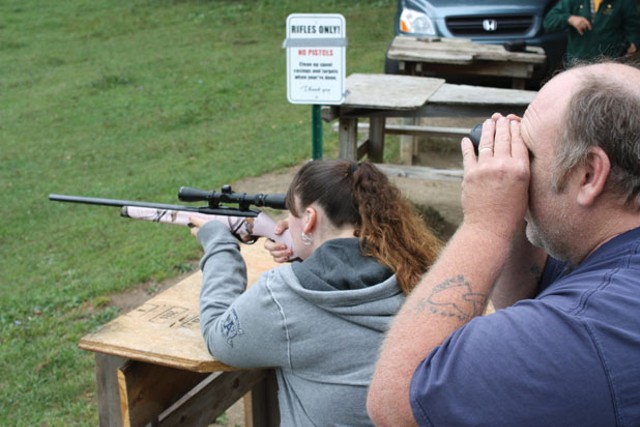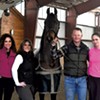Published September 22, 2010 at 8:29 a.m.
The Holsteins grazing on the hillside behind the Laberges’ dairy barn in Charlotte seem blissfully indifferent to the crackle of nearby gunfire punctuating the warm air. The periodic rat-tat-tat of semiautomatic weapons doesn’t spook the cows, but it gives momentary pause to this two-legged visitor, as does the sign posted outside the Laberge and Sons gun range:
“Shooting here is not a right, it's a privilage [sic],” it reads. “Comply with these rules or you will not return.”
Not return? The statement sounds like a threat, but I soon discover the Laberges are actually quite welcoming to uninvited guests. For years, the family has allowed police, hunters, National Guard members and other Vermonters to shoot on its property. Local gun owners say it’s one of few places in Chittenden County where civilians can practice firing a rifle, pistol or shotgun without joining a private club.
The shortage isn’t limited to Chittenden County. There are surprisingly few publicly accessible ranges around the state. Yet Vermont has some of the most lenient gun laws in the nation, and the highest per-capita rate of gun ownership in New England — more than four in 10 Vermonters own a firearm, according to a 2001 behavioral-risk survey published in the Washington Post.
What happens when there are lots of guns but few safe and well-designed places to shoot them? Both a hunter-education expert at the Vermont Fish & Wildlife Department (FWD) and the lead firearms instructor at the Vermont Criminal Justice Training Council say Vermont’s shortage of ranges creates problems for gun owners and nonowners alike. Several accidental shootings in recent years, including the 2008 death of John Reiss, a former professor at St. Michael’s College, highlight the seriousness of the issue.
On this weekday afternoon, I poke my head into the Laberges’ milking parlor, just outside the range on Lime Kiln Road, and ask for permission to enter. I’m greeted by Mark Laberge, 52, a genial dairyman whose family has owned the 187-acre farm on the Charlotte-Shelburne border since 1943. Charlotte, often associated with luxury homes and spectacular views, seems an unlikely locale for a gravel quarry that doubles as a shooting gallery.
There’s another way in which the Laberge range is a holdover from Vermont’s agrarian past: Even in this litigious age, the family doesn’t ask visitors to sign an insurance waiver. They just have to obey the rules, clean up after themselves and perhaps drop a few bucks in the donation box on the way out.
Laberge politely declines to speak on the record for this story, explaining that he’s had legal conflicts with a neighbor in recent years and doesn’t want to stir up more trouble. Nevertheless, he grants me permission to enter his property, meet his guests and do some shooting myself.
I follow a rutted dirt road through the cow pasture, past an old motorboat, some rusty farm equipment, and mounds of sand, concrete and corrugated metal. The road quickly descends into a narrow ravine and snakes past some willow trees and a Caterpillar earth mover parked beside a gouged-out hillside.
The road forks at the bottom of the hill, where a hand-painted sign directs “rifle and muzzleloaders” to the right and “pistol and shotgun” users to the left. I turn right and park at the edge of a meadow beside a wooden bench and shooting stand.
There, Joe Corcoran of Winooski stares through binoculars at a target about 60 yards away. Corcoran’s 16-year-old daughter, Amanda, sits on the bench in front of him aiming her pink-and-green-camouflage .22-caliber hunting rifle. The girl concentrates, then slowly squeezes off a few rounds, causing tiny puffs of dirt to fly at the end of the field.
“You’re low,” Corcoran tells his daughter, who makes a minor adjustment to her scope.
Corcoran explains that he and Amanda have come here from Winooski to sight her gun before deer rifle season starts on November 13. Although father and daughter both enjoy shooting at Laberge’s, they say they’d prefer to find a public range closer to home. Corcoran doesn’t know of one.
A couple of hundred yards up the road is a small, circular clearing facing an eroded hillside littered with bullet-riddled aluminum cans and milk jugs. Two men stand behind a Chevy pickup and load their handguns from boxes of ammo on the tailgate.
One of them, “Dave,” is a 38-year-old small-business owner who grew up in the area. He asks that his real name not be used because, he says, “I’ve got 150 customers, and they may not all share my views on guns.”
As Dave feeds rounds into the clip of his 9mm semiautomatic, he says he comes here 10 to 15 times a year, primarily because there are no formal ranges near his home. He admits this is not the safest place to shoot; he describes Laberge’s as “self-regulated,” meaning shooters are responsible for their own safety. And, while he’s never heard of anyone getting injured here, Dave says he’s selective about when, and with whom, he shoots.
His concern is understandable. About 200 yards away, Amanda Corcoran is still shooting her rifle, and I can hear the bullets whizzing through the trees to my right. If she were to turn the gun muzzle 45 degrees to her left, I’d be in her direct line of fire.
Dave’s friend, “Rich,” is a burly 25-year-old with a shaved head and black sunglasses. He aims a silver-and-white .40-caliber pistol and pops off a dozen rounds in rapid succession at a target stapled to lawn signs for GOP candidates — for governor and lieutenant governor, respectively — Brian Dubie and Phil Scott. (Their choice of targets isn’t a political statement; Dave and Rich insist the signs were already here when they arrived.)
Rich doesn’t get to the range much anymore, he says; he’s home on a two-week leave from a yearlong deployment in Afghanistan. “I get plenty of shooting practice there,” he jokes.
Both men say they’d prefer to shoot at a more “structured” facility, especially an indoor one in the winter, but no such local range is regularly open to the public. Several fish-and-game clubs offer limited public access, but few allow handguns.
“That’s a very real demand that’s not being met,” Dave adds. “If someone could open an indoor range, they’d have no problem filling their membership.”
Some would say the Laberges are providing a public service, if only by keeping gun owners from discharging their weapons in more dangerous places, such as on public land or in their own backyards. Gun ranges are not officially regulated in Vermont, but state officials say facilities such as this one are on their way to becoming things of the past.
Just last week, the Agency of Natural Resources closed an unofficial shooting area on state-owned land in Middlesex after a safety assessment determined the site wasn’t appropriate for target practice. According to an ANR spokesperson, people were firing guns across an active public road.
Makeshift shooting ranges can be lethal, as several recent tragedies demonstrate. Reiss was killed in his own home in Essex by a stray bullet from a Soviet-era SKS semiautomatic carbine. Although investigators never determined who fired the deadly shot, 40-year-old Joe McCarthy of Essex was sentenced to two years in prison earlier this year for setting up a range in his backyard and inviting friends to shoot there.
Such accidents don’t occur only in densely populated towns. Last month, 76-year-old Peter Damone of Bridport was injured by a .45-caliber bullet that strayed from a home shooting range. According to published reports, Tracy Stone, 35, was target shooting in his backyard when one of his bullets allegedly traveled nearly a half mile and hit Damone in the face. Addison County doesn’t have a fish-and-game club with a gun range.
“Traditionally, we’ve been a rural state, and it was quite acceptable and convenient to go out in your backyard and shoot,” says Chris Saunders, FWD’s hunter education coordinator. “Obviously, those days came to an end quite a while ago.”
But, in a state with more than 70,000 licensed resident hunters and an unknown number of handgun owners — virtually anyone who’s not a convicted felon can own and carry one, with no registration or training requirements — it’s inevitable that gun owners will shoot somewhere.
“Fish & Wildlife recognized a while ago that, if we don’t have safe and environmentally responsible ranges, we’re not going to have hunters who practice their skills,” Saunders adds. “If anything, both of those tragedies [in Essex and Bridport] show the need for more public shooting ranges in this state and the need to improve what we have.”
FWD’s website lists 31 ranges statewide, many of which aren’t open to the public. Only seven are indoors. That creates problems not just for hunters and recreational shooters, but also for police, who face significant challenges in finding safe, environmentally responsible places to train year round.
“It’s a constant struggle,” says Deputy Chief Walt Decker of the Burlington Police Department. BPD’s officers typically train at the Ethan Allen Firing Range, a military-run facility in Jericho. “There are times when you’re shooting in the pouring rain, or the snow is coming down, or the wind is blowing.”
The BPD isn’t the only agency facing such difficulties. Lt. Robin Hollwedel of the Essex Police Department has been a firearms instructor at the Vermont Criminal Justice Training Council since 1983 and the Police Academy’s lead instructor since 1988. Over the years, he’s trained thousands of police officers to safely handle a gun.
“I believe in a lot of training, especially for something like firearms,” says Hollwedel, whose own officers visit the range at least four times a year. “It’s not only for the liability issue. We don’t want guys running around with guns who aren’t trained.”
State law requires that police officers pass a test to recertify with their handguns just once a year. Vermont has no other requirement that active-duty cops practice shooting on a regular basis. Hollwedel believes officers from the “majority” of police agencies in the state shoot just that once.
“That’s not really training,” he says. “That’s qualifying.”
What keeps Vermont’s cops from practicing more often? Budgetary and scheduling constraints are major factors, says Hollwedel, and the shortage of ranges exacerbates the problem.
It may seem counterintuitive, he adds, but the more time cops spend on the range, the less likely they are to resort automatically to the use of deadly force in actual confrontations. Hollwedel believes police should train regularly under a variety of conditions, such as close-quarter and low-light scenarios, where most real-life police shootings occur.
He says he’d like to see a “collaborative” indoor range open somewhere in Chittenden County that involves several departments, so each one can rotate its officers through on a regular basis without driving up their overtime budgets.
It was Hollwedel’s department that investigated the 2008 shooting death of Reiss. While Hollwedel doesn’t directly attribute that tragedy to Vermont’s shortage of ranges, he suggests it may have been a contributing factor.
Evan Hughes, vice president of the NRA-affiliated Vermont Federation of Sportsmen’s Clubs, agrees.
“We’re trying to get guys to migrate out of these backyard [shooting] situations,” says Hughes. “It’s kind of an ‘if you build it, they will come’ thing.”
Hughes has been working with FWD officials to do just that. This fall, the agency began a five-year grant program to build new ranges and upgrade existing ones. The $75,000 grants, issued once a year, will draw from funds collected under a federal excise tax on the sale of all guns and ammunition.
Although the program is a step in the right direction, $75,000 will only go so far. As FWD’s Saunders points out, an outdoor range can cost $100,000 to $150,000. Indoor ranges are considerably more expensive, because they require complex ventilation systems that filter out lead and gunpowder dust.
Even fully funded new ranges would undergo the considerable scrutiny aimed at any development in Vermont, including Act 250 reviews, environmental permitting for storm-water control, lead abatement, and probable opposition from neighbors concerned about noise, traffic and firearms in general. As the Bennington Banner reported last week, the Hale Mountain Fish & Game Club in Shaftsbury, which has existed since the 1940s, has been embroiled in a permitting dispute with its neighbors since 2004.
Until Vermont figures out how to address such conflicts, many gun owners in Chittenden and Addison counties will continue visiting the Laberge range, plinking beer cans and lawn signs. And, one hopes, they’ll keep their barrels pointed down range and stay out of the line of fire.
More By This Author
Speaking of...
-

'We Must Act Now': Burlington Council Passes Resolution on Drug Crisis, Public Safety
Oct 11, 2023 -

A Clothing-Optional Camp Hosted a Kinky Summer Soirée. Campers Awoke to the Crack of Gunfire.
Sep 27, 2023 -

Family Sues After Toddler Fatally Shoots Himself With Easy-to-Fire ‘Baby Glock’
Jul 26, 2023 -

Video: Gail and George Africa of Vermont Flower Farm Plan to Retire
Sep 8, 2022 -

Under New Ownership, Turtle Fur Plans to Expand Its Offerings
Aug 1, 2022 - More »
Comments
Showing 1-1 of 1
Comments are closed.
From 2014-2020, Seven Days allowed readers to comment on all stories posted on our website. While we've appreciated the suggestions and insights, right now Seven Days is prioritizing our core mission — producing high-quality, responsible local journalism — over moderating online debates between readers.
To criticize, correct or praise our reporting, please send us a letter to the editor or send us a tip. We’ll check it out and report the results.
Online comments may return when we have better tech tools for managing them. Thanks for reading.














































